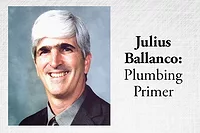For Your Own Health
Ergonomics is one of those $10 words meaning the way we move when performing our job. Studying the motion of construction employees is nothing new. Ergonomics may be a word that has recently come into vogue, but it has been a part of the construction profession for the past century. My introduction into this field came while studying the work of Frank Gilbreath, one of the great industrial engineers of this century. Gilbreath was immortalized in the book, Cheaper By The Dozen.
One of Gilbreath’s first great discoveries made bricklayers more efficient. Gilbreath invented the multiple-level scaffold. Prior to this invention, the bricks, mortar and bricklayer were all situated on the same level. Gilbreath located the bricks on one level, the mortar on another and the brick layer on a third level. This simple invention increased a bricklayer’s performance nearly fourfold. It also reduced a strain on the bricklayer’s back and arms.
When you consider the motions used in the plumbing industry, any OSHA regulation may be disastrous. Think of how we pick up a water closet by the throat. The lifting is all in the back. Have you ever crawled into a tight location only to lift a wrench over your head to tighten something? These types of motions put severe stress and strain on our various body parts. Plumbers are known for having bad backs. It is the motions and positions we assume in carrying out our job that result in these back injuries.
I remember as a kid lifting extra heavy cast iron on the jobsite. My father instructed everyone who worked for him to lift the cast iron with the knees and always have two people lift a 10-footer. When he left the jobsite, we bent over to lift the cast iron and thought nothing of picking up a 10-footer by ourselves. After all, it was only 160 pounds.
When I went to the doctor to review a back X-ray, he informed me that I had three rounded vertebrae. Then he asked why I lifted weights as a kid before my body was fully developed. I told him that I had never lifted weights in my youth. He responded that I must have since that is what caused the condition in my back. That’s when I remembered the extra heavy cast-iron 10-footers.
Whether OSHA regulates ergonomics or not, checking the proper motions to use to reduce injuries is always a good idea. We don’t really need federal regulations, we need to use common sense.
Don’t Be Fooled: After finishing up with our ergonomics discussion, my friend and I began to talk about death. I know that sounds strange, however, a classmate of mine recently died. Don’t be fooled by the white hair in my photograph, I’m still a young guy. Classmates shouldn’t be dying. Shortly thereafter, another friend went through an emergency angioplasty, which is when they snake out the blood vessels in and around your heart.
After the angioplasty, his message to me was, “What have you done lately to check your health?” I had to admit, “Nothing.”
When the insurance man came around the next time, I changed the policy to include a well care rider. It allows everyone covered by the policy to have an annual physical exam, costing up to $150. It also allows the policy to cover additional well care and preventive care tests once the deductible is met. It includes mammograms, pap smears, stress test, hearing tests, heart angiograms, etc. I was surprised at how little the rider cost.
Over the Christmas holidays, I put the new insurance policy to the test. I spent an hour at the hospital getting a heart angiogram, followed by a stress test. Prior to the start of the stress test, I tried to get the reading as low as possible on the monitor for my heart rate. I felt real good that I could reach 52 beats per minute. Most adult males have an “at rest” heart rate of between 62 and 72 beats per minute.
The following day, I was in for a hearing test. My family often claims that I don’t hear as well as I used to. I say it’s selective hearing.
When I returned to the heart doctor for the results, he said the news was very good. My heart was as strong as an ox. He told me he would see me again when I’m collecting Social Security.
The news from the hearing test was not as good. I had suffered minor hearing loss in both ears. I was informed once you lose it, the hearing never comes back. That was a scare I didn’t want to hear. Then the questions came about hearing protection on a jobsite. I said when on construction sites, I am never in an area where hearing protection is required.
The doctor said, “I don’t care what OSHA says, a construction site is a noisy place. From now on, wear hearing protection. Furthermore, when you mow the lawn or use any power tools, use hearing protection. If not, prepare to lose more of your hearing.”
The well care policy worked! It gave me a wake up call. Fortunately, I caught it early. So I ask each of you, “Do you have a well care rider?”
Employers should look into providing it for their employees. Employees should be asking for it from their employers. For a few bucks more, it is worth getting many more years out of your employees. Just think what it costs to train new employees. You work hard so you can enjoy your retirement. Just make sure you’re around when the time for retirement comes.
Looking for a reprint of this article?
From high-res PDFs to custom plaques, order your copy today!








